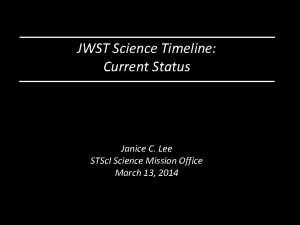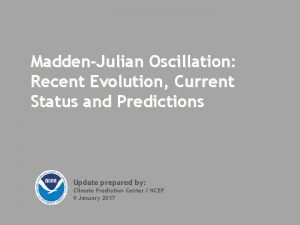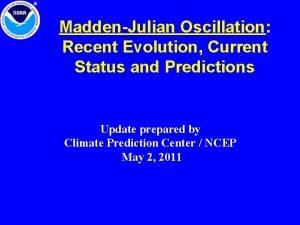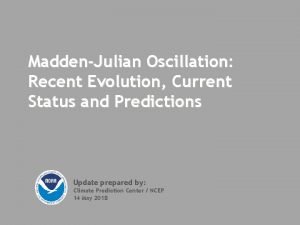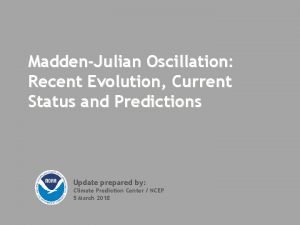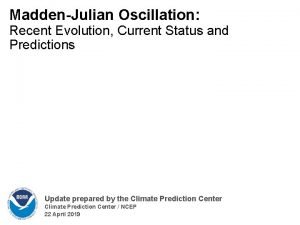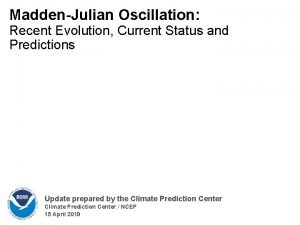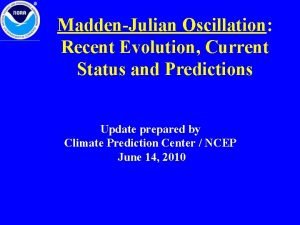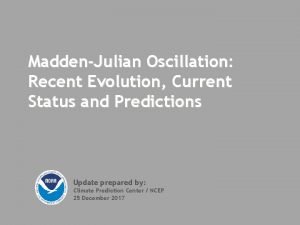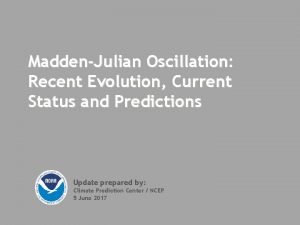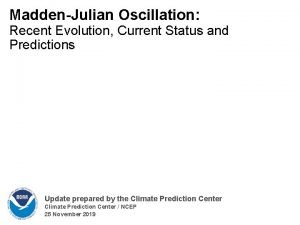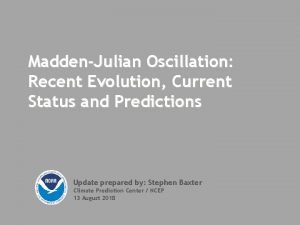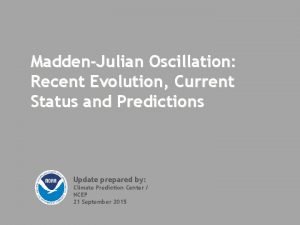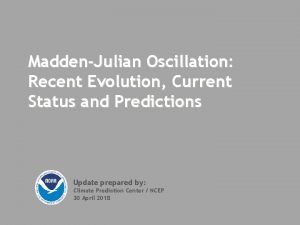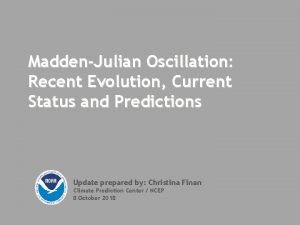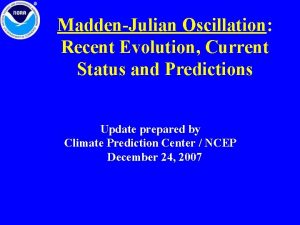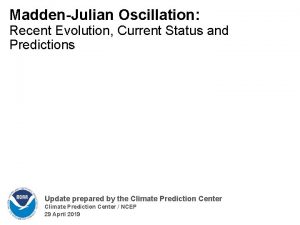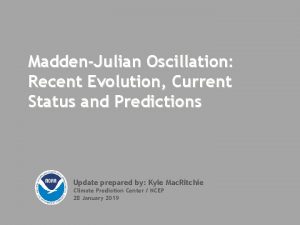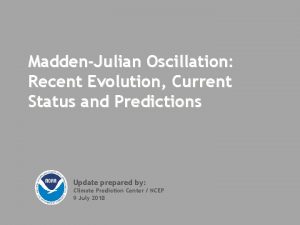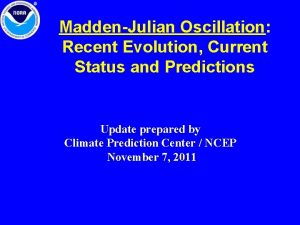MaddenJulian Oscillation Recent Evolution Current Status and Predictions





















- Slides: 21

Madden-Julian Oscillation: Recent Evolution, Current Status and Predictions Update prepared by Climate Prediction Center / NCEP February 13, 2012

Outline • Overview • Recent Evolution and Current Conditions • MJO Index Information • MJO Index Forecasts • MJO Composites

Overview • The MJO continued to propagate eastward across the central Pacific and western hemisphere during the past week. • Dynamical model MJO index forecasts show the MJO signal may continue through the period. There is some spread amongst the models for the amplitude and eventual phase by the end of Week -2, but several favor the enhanced phase moving into the Indian Ocean by the end of the period. Based on the latest observations and model forecasts, the MJO is forecast to remain active during the upcoming 1 -2 weeks. • The MJO is forecast to contribute to enhanced rainfall across parts of Brazil, Africa, and the Indian Ocean during the next two weeks. Suppressed convection is favored for the Maritime Continent and parts of northern Australia over the period. • In the short-term, during Week-1, enhanced precipitation is favored for some areas across the southern tier of the U. S. consistent with the MJO. As the MJO enhanced phase enters the Indian Ocean, there may be a tendency for troughs to impact much of the western U. S. favoring belownormal temperatures and later increasing chances of above-average precipitation during and beyond the extended range period. Additional potential impacts across the global tropics are available at: http: //www. cpc. ncep. noaa. gov/products/precip/CWlink/ghazards/index. php

850 -h. Pa Vector Wind Anomalies (m s-1) Note that shading denotes the zonal wind anomaly Blue shades: Easterly anomalies Red shades: Westerly anomalies developed over the Atlantic Ocean and Africa during the past five days. Westerly anomalies shifted eastward across the southern Pacific. Westerly wind anomalies strengthened over the eastern Pacific Ocean.

850 -h. Pa Zonal Wind Anomalies (m s-1) Westerly anomalies (orange/red shading) represent anomalous west-to-east flow Easterly anomalies (blue shading) represent anomalous east-to-west flow In early October, MJO activity weakened the persistent easterly anomalies across the central Pacific (first dashed line). Time MJO activity continued into December (altering dashed and dotted lines), but then westerly (easterly) wind anomalies across the Indian Ocean (western Pacific) became more stationary. In mid-January, interaction with the extratropics contributed to decreased easterlies near the Date Line. Recently, westerly anomalies shifted eastward into the western Pacific. Longitude

OLR Anomalies – Past 30 days Drier-than-normal conditions, positive OLR anomalies (yellow/red shading) Wetter-than-normal conditions, negative OLR anomalies (blue shading) During mid-January, suppressed convection was observed in the central and southwest Pacific. The MJO contributed to enhanced convection across the eastern Indian Ocean, Maritime Continent, and South Pacific Convergence Zone (SPCZ) in late January. During early February, the MJO contributed to enhanced (suppressed) convection across the southern Pacific, Central America, northern South America, and the equatorial Atlantic Ocean (eastern Africa).

Outgoing Longwave Radiation (OLR) Anomalies (7. 5°S-7. 5°N) Drier-than-normal conditions, positive OLR anomalies (yellow/red shading) Wetter-than-normal conditions, negative OLR anomalies (blue shading) (Courtesy of CAWCR Australia Bureau of Meteorology) Beginning in mid-September, enhanced convection shifted from southern Asia to the western Pacific while suppressed convection developed during late September across India and also shifted eastward to the western Pacific. Time MJO activity continued into early December, then OLR anomalies decreased and eastward propagation was not clear. However, during late December, eastward propagation of OLR anomalies was again observed. Strong enhanced convection developed across the eastern Indian Ocean during late January and shifted eastward into the western Pacific in early February. Longitude

200 -h. Pa Velocity Potential Anomalies (5°S-5°N) Positive anomalies (brown shading) indicate unfavorable conditions for precipitation Negative anomalies (green shading) indicate favorable conditions for precipitation Beginning in the second half of September into December, alternating negative (dashed lines) and positive (dotted lines) anomalies were evident and associated with MJO activity during the period. Time Eastward propagation of anomalies became less coherent during late December and early January and anomalies weakened. Eastward propagation again became evident in late January. Longitude

IR Temperatures (K) / 200 -h. Pa Velocity Potential Anomalies Positive anomalies (brown contours) indicate unfavorable conditions for precipitation Negative anomalies (green contours) indicate favorable conditions for precipitation The large scale velocity potential pattern exhibits a clear wave-1 structure that has been shifting eastward during the past week.

200 -h. Pa Vector Wind Anomalies (m s-1) Note that shading denotes the zonal wind anomaly Blue shades: Easterly anomalies Red shades: Westerly anomalies During the past five days, the core of the westerly anomalies (red boxes) shifted from the eastern Pacific to the Atlantic, Africa and western Indian Ocean.

200 -h. Pa Zonal Wind Anomalies (m s-1) Westerly anomalies (orange/red shading) represent anomalous west-toeast flow Easterly anomalies (blue shading) represent anomalous east-to-west flow Alternating westerly (dashed lines) and easterly (dotted lines) anomalies are evident from mid-September into December associated with the MJO. Time In December, westerly anomalies strengthened over the Pacific but remained generally stationary. Later in January, these westerly anomalies have shown eastward propagation across the Pacific, followed by easterly anomalies. Longitude

Weekly Heat Content Evolution in the Equatorial Pacific An oceanic Kelvin wave (dashed line) shifted eastward during February and March 2011. Since late July, negative heat content anomalies are evident across the equatorial central and eastern Pacific. Time In January 2012, negative heat content anomalies have weakened in the central equatorial Pacific. Longitude

MJO Index -- Information • The MJO index illustrated on the next several slides is the CPC version of the Wheeler and Hendon index (2004, hereafter WH 2004). Wheeler M. and H. Hendon, 2004: An All-Season Real-Time Multivariate MJO Index: Development of an Index for Monitoring and Prediction, Monthly Weather Review, 132, 1917 -1932. • The methodology is very similar to that described in WH 2004 but does not include the linear removal of ENSO variability associated with a sea surface temperature index. The methodology is consistent with that outlined by the U. S. CLIVAR MJO Working Group. Gottschalck et al. 2010: A Framework for Assessing Operational Madden-Julian Oscillation Forecasts: A CLIVAR MJO Working Group Project, Bull. Amer. Met. Soc. , 91, 1247 -1258. • The index is based on a combined Empirical Orthogonal Function (EOF) analysis using fields of near-equatorially-averaged 850 -h. Pa and 200 -h. Pa zonal wind and outgoing longwave radiation (OLR).

MJO Index -- Recent Evolution § The axes (RMM 1 and RMM 2) represent daily values of the principal components from the two leading modes § The triangular areas indicate the location of the enhanced phase of the MJO § Counter-clockwise motion is indicative of eastward propagation. Large dot most recent observation. § Distance from the origin is proportional to MJO strength § Line colors distinguish different months During the first half of January the MJO index was fairly weak with no eastward propagation. In late January, the amplitude increased over the Maritime continent, and during the past three weeks eastward propagation is evident.

MJO Index – Historical Daily Time Series Time series of daily MJO index amplitude from 1997 to present. Plots put current MJO activity in historical context.

Ensemble GFS (GEFS) MJO Forecast Yellow Lines – 20 Individual Members Green Line – Ensemble Mean RMM 1 and RMM 2 values for the most recent 40 days and forecasts from the ensemble Global Forecast System (GEFS) for the next 15 days light gray shading: 90% of forecasts dark gray shading: 50% of forecasts The ensemble GFS forecasts the MJO signal to continue propagating eastward over the next week with the enhanced phase in the western hemisphere and Africa. During the end of Week-1, the MJO signal is forecast to weaken.

Ensemble Mean GFS MJO Forecast Figures below show MJO associated OLR anomalies only (reconstructed from RMM 1 and RMM 2) and do not include contributions from other modes (i. e. , ENSO, monsoons, etc. ) Spatial map of OLR anomalies for the next 15 days The ensemble mean GFS forecast indicates enhanced convection across Brazil and Africa during the next week with suppressed convection across the eastern Indian Ocean and Maritime Continent. Time-longitude section of (7. 5°S-7. 5°N) OLR anomalies for the last 180 days and for the next 15 days

Constructed Analog (CA) MJO Forecast Figure below shows MJO associated OLR anomalies only (reconstructed from RMM 1 and RMM 2) and do not include contributions from other modes (i. e. , ENSO, monsoons, etc. ) Spatial map of OLR anomalies for the next 15 days The CA forecast shows enhanced convection over Brazil and Africa and suppressed convection over the eastern Indian Ocean and Maritime Continent during Week-1. During week-2, enhanced (suppressed) convection is indicated over Africa and the Indian Ocean (western Pacific). Time-longitude section of (7. 5°S-7. 5°N) OLR anomalies for the last 180 days and for the next 15 days

MJO Composites – Global Tropics 850 -h. Pa Wind Anomalies (Nov-Mar) Precipitation Anomalies (Nov-Mar)

U. S. MJO Composites – Temperature § Left hand side plots show temperature anomalies by MJO phase for MJO events that have occurred over the three month period in the historical record. Blue (orange) shades show negative (positive) anomalies respectively. § Right hand side plots show a measure of significance for the left hand side anomalies. Dark blue and purple shades indicate areas in which the anomalies are significant at the 95% or better confidence level. Zhou et al. (2011): A composite study of the MJO influence on the surface air temperature and precipitation over the Continental United States, Climate Dynamics, 1 -13, doi: 10. 1007/s 00382 -0111001 -9 http: //www. cpc. ncep. noaa. gov/products/precip/CWlink/MJO/mjo. shtml

U. S. MJO Composites – Precipitation § Left hand side plots show precipitation anomalies by MJO phase for MJO events that have occurred over the three month period in the historical record. Brown (green) shades show negative (positive) anomalies respectively. § Right hand side plots show a measure of significance for the left hand side anomalies. Dark blue and purple shades indicate areas in which the anomalies are significant at the 95% or better confidence level. Zhou et al. (2011): A composite study of the MJO influence on the surface air temperature and precipitation over the Continental United States, Climate Dynamics, 1 -13, doi: 10. 1007/s 00382 -0111001 -9 http: //www. cpc. ncep. noaa. gov/products/precip/CWlink/MJO/mjo. shtml
 Line current and phase current
Line current and phase current Power formula three phase
Power formula three phase Drift current and diffusion current
Drift current and diffusion current Ac theory 3 lesson 4
Ac theory 3 lesson 4 Drift current density unit
Drift current density unit What is diffusion current and drift current
What is diffusion current and drift current In a y-connected source feeding a ∆-connected load,
In a y-connected source feeding a ∆-connected load, Holding current and latching current
Holding current and latching current Drift current and diffusion current in semiconductor
Drift current and diffusion current in semiconductor Method of agitation for size separation
Method of agitation for size separation A jfet always operates with
A jfet always operates with Dcep welding
Dcep welding Touch current vs leakage current
Touch current vs leakage current Kcl mesh analysis
Kcl mesh analysis Current program status register
Current program status register Timeline jwst
Timeline jwst Current status of buddhism
Current status of buddhism Periodic motion examples images
Periodic motion examples images Non-thrust oscillation techniques
Non-thrust oscillation techniques Peripheral joint mobilization
Peripheral joint mobilization Dynamics
Dynamics Joint play grades
Joint play grades















